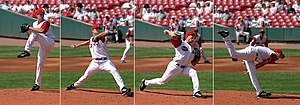Animation - Rules of Animation
Animation 06/10/21:
Squash and Stretch:
To give a sense of weight and flexibility to and object the shape should be changed in accordance with it’s movement.
However, the volume of the object must not be changed when it is being squashed or stretched, in order to mimic the laws of physics.
anticipation is used to prepare for an action. in order to make the action appear to be more realistic. there but be a build up to an action in order for it to be believable.
For example, before throwing a ball, the pitcher must pull their arm back in order to prepare for the motion. This must also be put into practice in animation in order to create a sense of realism.
The purpose of staging is the direct the viewers attention and show that in the scene is important. This can be done through how the character is place in the frame, through the use of light and shadow, or the angle and position of the camera.
Two different approaches to the process of drawing. Straight ahead scene are done frame by frame throughout from beginning to end . But pose to pose scene start by drawing the key frames in a an animation and then filling in the gaps.
Straight ahead can be very useful for giving the illusion of dynamic movement, e.g. animation flames. While pose to pose works better for dramatic and emotional scenes where composition is more important. normally a combination of these techniques is used.
Follow though and overlapping are two related techniques that help for realistic movement. helping to follow the laws of physics. follow through involves loosely attacked pieces of the body should continue moving after the character has stopped then being puled back to the centre of mass to show a realistic action. Overlapping action si the tendency for body parts to move at different speeds. drag is also similar where as a part of the body moves is takes a few frames for the rest of the body to catch up.
The movement of objects need time to speed up and slow down, they don't immediately accelerate to a constant speed. so this needs to be shown is the animation to give a sense of realism. an object bust be shows to be SPEEDING UP and SLOWING DOWN rather than skipping that process all together.
Arc:
The path of an object or action is called an arc. E.g. a ball being thrown will following the laws of physics and be affected by gravity, causing it to move through the air in an arc.
Secondary Action:
An action that results directly from another action and are used to highlight the main animation in the scene and add a sense of realistic complexity to the animation.
Timing:
Refers to the number of frames between two poses. The object should follow the rules on physics to allow for a certain level of realism. A large object should to be moving in a way that is too fast for it to be realistic and vice versa, unless the context allows for it.
Exaggeration:
Over exaggerating movements to feel more dynamic, can bend the rules of physics to allow for more appeal and can also be useful for comedy.
Solid Drawing:
Understanding fundamentals of drawing is needed. Character style should match the style of animation for the viewers to find it believable.
Appeal:
Appeal to the viewer, easy to read design, no clutter, personality, are all important factors in appealing to the viewers. Too much clutter in an animation will distract the viewer and take away from the main animation.








Comments
Post a Comment